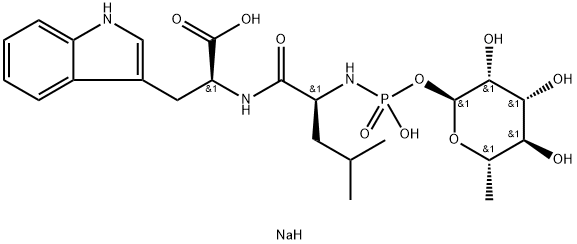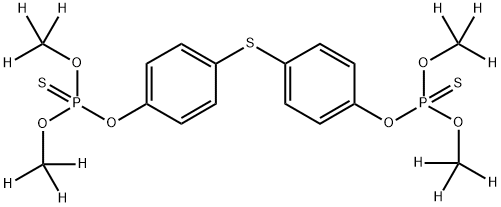Temephos
- CAS NO.:3383-96-8
- Empirical Formula: C16H20O6P2S3
- Molecular Weight: 466.47
- MDL number: MFCD00128034
- EINECS: 222-191-1
- SAFETY DATA SHEET (SDS)
- Update Date: 2025-01-27 09:38:02

What is Temephos?
Description
Abate is the trade name for Temephos, the known organophosphate larvicide. Abate is used to treat water infested with disease-carrying fleas and control mosquito, midge, and black fly larvae. Abate quickly controls mosquito and other insect populations because it kills insect larvae before they mature, and the residual activity of abate prevents insect populations. On decomposition, abate produces oxides of carbon, phosphorous, and sulphur. Exposures to abate in workplaces cause adverse health effects (refer to Temephos for details).
Chemical properties
Temephos is a solid at room temperature and is composed of colorless crystals. As a liquid, it is brown and viscous. Temephos is a non-systemic insecticide. It is insoluble in water, hexane, and methyl cyclohexane, but soluble in common organic solvents. It is combustible and the liquid formulations contain organic solvents that may be flammable. Temophos decomposes on heating or burning, producing toxic fumes such as phosphorus oxides and sulfur oxides. Temephos reacts with strong acids and strong bases. The US EPA has grouped temephos as a GUP. Temephos is used for the control of mosquito, midge, and black fl y larvae. It is used in lakes, ponds, and wetlands. It may also be used to control fl eas on dogs and cats and to control lice on humans.
The Uses of Temephos
Temephos is an organophosphate larvicide used to treat water infested with disease-carrying insects.
The Uses of Temephos
Temephos is used to control mosquito and black fly larvae in aqueous environments and as a human and veterinary ectoparasiticide.
Definition
ChEBI: Temephos is an organic sulfide that is diphenyl sulfide in which the hydrogen at the para position of each of the phenyl groups has been replaced by a (dimethoxyphosphorothioyl)oxy group. It has a role as an EC 3.1.1.7 (acetylcholinesterase) inhibitor, an acaricide, an agrochemical and an ectoparasiticide. It is an organic thiophosphate, an organothiophosphate insecticide and an organic sulfide. It is functionally related to a 4,4'-thiodiphenol.
General Description
White crystalline solid or liquid. Boiling point 87°F. Used as an insecticide. Technical grade is a viscous brown liquid.
Reactivity Profile
Organothiophosphates are susceptible to formation of highly toxic and flammable phosphine gas in the presence of strong reducing agents such as hydrides. Partial oxidation by oxidizing agents may result in the release of toxic phosphorus oxides.
Hazard
Cholinesterase inhibitor. Questionable carcinogen.
Health Hazard
Exposures to high concentrations of temephos for a prolonged period of time cause poisoning to occupational workers. The symptoms include, but are not limited to, nausea, salivation, headache, loss of muscle coordination, and diffi culty breathing. Workers exposed to a combination of temephos and malathion suffer potentiation of toxicity of temephos. Exposures to granules of temephos formulation may cause irritation. Prolonged and repeated skin contact may cause irritation. Inhalation may cause respiratory irritation and chemical pneumonities. There are no reports on the prolonged effects of temephos.
Health Hazard
to avoid contamination of water, food, or feed, abate should be stored in a secure, dry,
Health Hazard
Abate is less toxic in comparison to withmost other organophosphorus pesticides.Among the test animals, rats showedalmost 10 times greater resistance to thiscompound than did mice and rabbits.In humans, ingestion can cause nausea,vomiting, diarrhea, and convulsions. Intakeof large amounts can result in respiratoryfailure.
LD50 value, oral (rats): 8600 mg/kg.
Agricultural Uses
Insecticide, Larvicide: Temephos is one of the few organophosphates that is registered to control mosquito larvae. It is a non-systemic insecticide for use on wetlands, ponds, lakes and other moist areas to control mosquito, gnat, black fly, midge, pinkie and sandfly larvae. Banned for use in EU countries[ 115]. Registered for use in the U.S.
Trade name
27165®; ABAT®; ABATE®; ABATE® 1-SG; ABATE® 2-CG; ABATE® 4-E; ABATE® 5CG; ABATHION®; AI3-27165®; AC 52160®; AMERICAN CYANAMID AC-52,160®; AMERICAN CYANAMID CL-52160®; AMERICAN CYANAMID E. I.52,160®; BIOTHION®; BITHION®; CL 52160®; DIFENPHOS®; DIFENTHOS®; DIFOS®; DIPHOS®; ECOPRO®; ECOPRO® 1707; EI 52160®; NEPHIS®; NEPHIS® 1G; NIMITEX®; NIMITOX®
Safety Profile
Posion by ingestion Moderately toxic by intraperitoneal, subcutaneous, and skin contact routes. An experimental teratogen. A skin irritant. A cholinesterase inhibitor type of insecticide. When heated to decomposition it emits toxic fumes of POx and SOx. See also PARATHION,
Carcinogenicity
The EPA noted a chronic dog
study (period of exposure not specified) in which significant
inhibition of plasma and RBC cholinesterase occurred at
dietary exposures equivalent to 12.5 mg/kg/day but not at
0.46 mg/kg/day .
No evidence of carcinogenicity or other treatment-related
effects occurred in rats fed a diet that contained 0, 10, 100, or
300 ppm temephos (equivalent to about 0.5, 5.0, or 15 mg/kg/
day) for 2 years . The animals in the treated groups
were exposed in utero from gestation day 12 through parturition
to 100 ppm of the test material, and at weaning pups
were randomly allocated to the three treatment groups and
the treatment initiated.
Metabolic pathway
Temephos is comparatively stable to metabolic degradation in both animals and plants. The main pathway is via thiooxidation to the sulfoxide and through hydrolysis to yield 4,4’-thiodiphenol and its thiooxidised derivatives which are conjugated as glucosides in plants and as sulfate esters in rats. Oxidative desulfuration to temephos oxon is apparently a minor pathway.
storage
During use and handling of abate, occupational workers/applicators should wear long- sleeved shirts, long pants, shoes, and socks, chemical-resistant gloves, and protective eyewear, goggles, or safety glasses. Flaggers must wear chemical-resistant headgear and protective eyewear.
Degradation
Temephos is hydrolysed by strong acids and alkalis; its maximum stability is at pH 5-7 (PM). When a methanolic solution of temephos was exposed to sunlight it was rapidly decomposed resulting in the formation of at least eight photoproducts of which only temephos sulfoxide (2) and temephos sulfone (3) were identified. The sulfoxide was the major initial product but it was further photolysed to the sulfone (3) which was apparently refractory to further degradation suggesting that the other unidentified photoproducts arose directly from temephos or from the sulfoxide (2) (Rosen, 1972) (Scheme 1).
Toxicity evaluation
Temephos has a very low mammalian toxicity; acute oral LD50 for male and female rats is 4204 and >10,000 mg/kg, respectively. NOEL (2 yr) for rats is 300 mg/kg diet (15 mg/kg/d). Temephos administered orally to rats is eliminated in the feces and urine. The major elimination compound is unchanged temephos. Other urinary metabolites are sulfate ester conjugates of 4,4 -thiodiphenol, its sulfoxide, and sulfone.
Properties of Temephos
| Melting point: | 30-31°C |
| Boiling point: | 518.5±60.0 °C(Predicted) |
| Density | 1.3200 |
| vapor pressure | 9.5×10-6Pa (20-25 °C) |
| storage temp. | 2-8°C |
| solubility | DMSO : ≥ 100 mg/mL (214.38 mM) |
| form | solid |
| color | Colorless to light yellow |
| Water Solubility | 0.003 g/100 mL |
| Merck | 13,9214 |
| BRN | 1896901 |
| CAS DataBase Reference | 3383-96-8(CAS DataBase Reference) |
| NIST Chemistry Reference | Temefos(3383-96-8) |
| EPA Substance Registry System | Temephos (3383-96-8) |
Safety information for Temephos
| Signal word | Danger |
| Pictogram(s) |
 Skull and Crossbones Acute Toxicity GHS06  Environment GHS09 |
| GHS Hazard Statements |
H302:Acute toxicity,oral H311:Acute toxicity,dermal H410:Hazardous to the aquatic environment, long-term hazard |
| Precautionary Statement Codes |
P264:Wash hands thoroughly after handling. P264:Wash skin thouroughly after handling. P270:Do not eat, drink or smoke when using this product. P273:Avoid release to the environment. P280:Wear protective gloves/protective clothing/eye protection/face protection. P301+P312:IF SWALLOWED: call a POISON CENTER or doctor/physician IF you feel unwell. |
Computed Descriptors for Temephos
Temephos manufacturer
New Products
6-Bromo-3-iodo-1-methyl-1H-indazole 7-Bromo-1H-indazole 3-(2,4-Dimethoxybenzyl)dihydropyrimidine-2,4(1H,3H)-dione N-octanoyl benzotriazole 4-Hydrazinobenzoic acid ELECTROLYTIC IRON POWDER 1,1’-CARBONYLDIIMIDAZOLE R-2-BENZYLOXY PROPIONIC ACID 1,1’-CARBONYLDI (1,2-4 TRIAZOLE) 4-HYDROXY BENZYL ALCOHOL 4-IODO BENZOIC ACID 4-Bromopyrazole 1-Boc-4-cyanopiperidine 5-BROMO-2CYANO PYRIDINE (R)-5-(2-aminopropyl)-2-methoxybenzenesulfonamide 5,6-Dimethoxyindanone Cycloleucine 1-Aminocyclobutanecarboxylic acid 1-Amino-1-cyclohexanecarboxylic acid 1-(2-Ethoxyethyl)-2-(piperidin-4-yl)-1H-benzo[d]imidazole hydrochloride TETRABUTYLAMMONIUM CYANIDE 4-bromo-3,5-dimethylbenzenesulfonyl chloride N-(5-Amino-2-methylphenyl)acetamide 4-EthylbenzylamineRelated products of tetrahydrofuran








You may like
-
 3383-96-8 Temephos 98%View Details
3383-96-8 Temephos 98%View Details
3383-96-8 -
 3383-96-8 98%View Details
3383-96-8 98%View Details
3383-96-8 -
 Temephos 98%View Details
Temephos 98%View Details
3383-96-8 -
 Temephos 3383-96-8 98%View Details
Temephos 3383-96-8 98%View Details
3383-96-8 -
 Temephos 98%View Details
Temephos 98%View Details
3383-96-8 -
 Temephos CAS 3383-96-8View Details
Temephos CAS 3383-96-8View Details
3383-96-8 -
 Temephos CAS 3383-96-8View Details
Temephos CAS 3383-96-8View Details
3383-96-8 -
![1841081-72-8 1-(2-Ethoxyethyl)-2-(piperidin-4-yl)-1H-benzo[d]imidazole hydrochloride 98+](https://img.chemicalbook.in//Content/image/CP5.jpg) 1841081-72-8 1-(2-Ethoxyethyl)-2-(piperidin-4-yl)-1H-benzo[d]imidazole hydrochloride 98+View Details
1841081-72-8 1-(2-Ethoxyethyl)-2-(piperidin-4-yl)-1H-benzo[d]imidazole hydrochloride 98+View Details
1841081-72-8